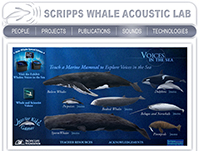Listening
to Gray Whales: Acoustic Monitoring
By Journey North and Michael H. Smith, Project Coordinator
for Gray
Whales Count
On
March 13, 2009, an exciting new phase of the Gray Whales Count project
began: acoustic
monitoring. A team of scientists from the Marine
Physical Laboratory at Scripps Institution of Oceanography set
up instruments to record underwater sounds made by the whales migrating
past the Gray Whales Count site. These special tools will continuously
record underwater sound data for two months, 24/7. The
sound data
will capture the flow of the migration, including cow/calf pairs.
What
Sounds Are Scientists Recording?
In addition to whale vocalizations, we will be recording all the sounds
of the Coal Oil Point environment. This includes other
marine mammals, and some noise that likely affects the whales’ migration:
vessel traffic, oil pumping at Platform Holly, 1.5 miles away, and
the natural
seeps of methane gas and oil that surround the Point. A UCSB dive boat
was at the site all day today, The dive boat was guided by Ira Leifer,
of the Marine Science Institute at UCSB.
Special
Tools Record Underwater Sounds
The main acoustic tools of scientists are called acoustic recording
packages (ARPs). These instruments sit on the seafloor. They
can continuously record underwater sound at rates up to 1 kHz
for durations over
one-year. ARPs were
developed by the Scripps
Whale Acoustic Lab and have
been
used worldwide for multi-year studies of baleen whale presence.
The lab is also
developing another, more capable,
high-frequency acoustic recording package (HARP), for
recording odonotocetes (toothed whales, such as sperm whales,
beaked whales, orca, dolphins, and others) at frequencies over
100 kHz.
Journal or Discussion Questions
- Whales, dolphins, and porpoises can send and receive underwater sound for communication or hunting purposes. Scientists observe and listen to the sounds of these marine mammals to learn about their seasonal and geographic (time-space) movements and about behavior characteristics. How do you think this information can help humans ensure a safer future for whales? What other uses might the information serve?
- Why do you think scientists know more about the sounds made by humpback whales than by gray whales? See what you can learn:
 |
Visit "Voices in the Sea" |
- Have other scientists studied the sounds gray whales make? Yes! What have they discovered? See: Sheyna Wisdom Listens to Whales >>
- Related Story: How did some sixth graders share in a scientist's work in monitoring sounds of endangered right whales in the far north? >>



